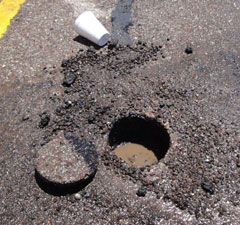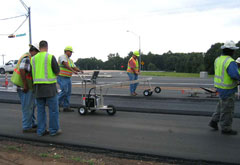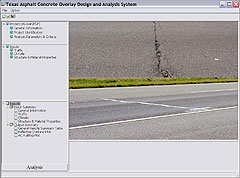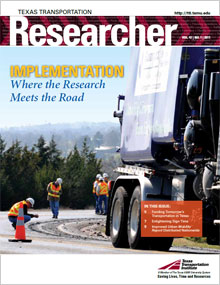Tying It All Together — Corridor Analysis
Maintaining the existing highway network is one of the Texas Department of Transportation’s (TxDOT‘s) top priorities. Many segments on important routes have now exceeded their design lives and are in need of major rehabilitation. To assist in this critical task, TxDOT contracted with the Texas Transportation Institute (TTI) to initiate a groundbreaking corridor analysis project. This new interagency agreement will permit TTI engineers to implement the products of many years of research while providing answers to TxDOT districts on the optimal approach to repair these distressed highways.

Working with TxDOT engineers, TTI has almost completed the first study on the Interstate 20 corridor in the Odessa District. “The length of the roadway is 165 miles, and it consists of 20 different pavement sections, each with different layer thicknesses and maintenance histories,” says Tom Scullion, the senior research engineer at TTI leading this effort. “The goal of the study is to develop a 10-year pavement rehabilitation plan for each section based on determining the underlying cause of the pavement problems.”
The research team initially conducted a full ground-penetrating radar (GPR) survey. Then after meeting with district personnel to discuss roadway history and priorities, the team executed a falling weight deflectometer test program to evaluate the in situ structural strengths and a verification field-sampling program. For each section, the cause of the distress, the most appropriate repair strategy and the priority of the work were reported to senior district personnel.
“Priority 1 projects were identified as those that have essentially failed and need full rehabilitation in the next 2 years. Priority 4 projects are those judged structurally adequate for the next 10 years,” says Scullion.
This project has generated substantial interest within TxDOT, and work is underway to evaluate three major U.S. routes in the Lubbock District. The team is also about to initiate an evaluation of Interstate 45 in the Bryan District.
An Eye Out for the Environment — Reclaiming Asphalt
In addition to conserving energy and protecting the environment, the use of reclaimed asphalt pavement (RAP) can significantly reduce the cost of asphalt mixes. These mixes continue to increase in cost, so savings benefit operating agencies. A key problem with RAP mixes is variability, which is the main reason why many state departments of transportation, including TxDOT, limit the use of RAP. In most circumstances, RAP variability is closely related to RAP stockpile management and RAP processing.

In 2010, TTI developed a set of state-of-the-practice guidelines for TxDOT regarding RAP processing and stockpile management. The principal points were to 1) eliminate contamination of RAP stockpiles, 2) keep RAP stockpiles as separate as possible, 3) blend thoroughly before processing or fractionating the multiple-source RAP stockpiles, 4) avoid over-processing, 5) use good practice when storing the processed RAP, and 6) characterize and number the processed RAP stockpiles.
“When properly designed and constructed, RAP mixes could have the same or similar performance as pure hot-mix asphalt [HMA] mixes,” says TTI Associate Research Engineer Fujie Zhou. “The stockpile management practices and RAP-processing techniques described in this report help TxDOT better control RAP variability.”
Related report: RAP Stockpile Management and Processing in Texas: State of the Practice and Proposed Guidelines, http://tti.tamu.edu/documents/0-6092-1.pdf
New Technologies for Assessing Hot-Mix Asphalt Overlays
HMA overlays are a critical part of TxDOT‘s maintenance program, as are methods to evaluate the quality and uniformity of the overlays. In 2006, TTI began a research project to evaluate several available non-nuclear density gauges and further refinement of infrared imaging and GPR for use in evaluating HMA overlays.

The project led to the development of data collection/analysis software and a new infrared sensor bar that is mounted on the back of a paver to provide uniformity in measurement. These technologies provide a much-improved method to collect and analyze HMA-paving projects for uniformity and quality as compared to traditional spot tests.
The technologies assist with the evaluation of segregation on a project, project uniformity and overall project quality. The PAVE-IR system can provide near 100 percent coverage of a paving project. Based upon work completed, the guidelines developed by TTI should serve to flag potentially segregated areas with thermal imaging. A new test procedure, Tx Method 244 F, has been developed by TxDOT, and in 2010, the Pave-IR system was included in the department’s construction specifications. (PAVE-IR is an infrared temperature bar system developed by TTI.)
“Based upon work completed,” Mikhail continues, “the guidelines developed by TTI should serve to flag potentially segregated areas with thermal imaging.”
Related report: New Infrared and Radar Systems for Detecting Segregation in Hot-Mix Asphalt Construction, http://tti.tamu.edu/documents/0-4577-2.pdf
Getting It Right the First Time — Proper Design of Asphalt Overlays
The placement of an asphalt overlay is the most common method used by TxDOT to rehabilitate existing asphalt and concrete pavements. The type of overlay and its required thickness are important decisions that TxDOT engineers make on a daily basis. To perform well, an asphalt overlay must have a balance of both good rut and crack resistance. Furthermore, overlay performance is highly influenced by many factors, such as existing pavement conditions, traffic loading and environmental conditions.

In response to the need, TTI conducted a research project with the objectives to develop 1) an HMA overlay mix design balancing rutting and reflective cracking requirements, 2) guidelines for evaluating existing pavements focusing on identifying repair locations and collecting information needed for the HMA overlay thickness design in which the primary concern is reflective cracking, and 3) an HMA overlay thickness design system focusing on reflective cracking and rutting.
In addition to three published reports, the TTI research team headed by Associate Research Engineer Fujie Zhou conducted several workshops to train TxDOT personnel on the Texas Asphalt Concrete Overlay Design and Analysis System (TxACOL). “We trained more than 30 representatives from TxDOT on how to use TxACOL software,” says TTI Division Head of Materials and Pavements Andrew Wimsatt. “The attendees practiced the software step by step and by the end of day knew how to properly design an asphalt overlay using the program.”
Related report: Mechanistic-Empirical Asphalt Overlay Thickness Design and Analysis System, http://tti.tamu.edu/documents/0-5123-3.pdf
